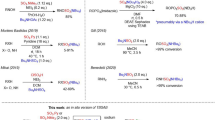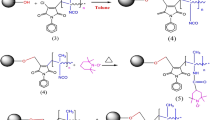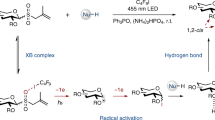Abstract
A facile method for activating hydroxyl groups of Sepharose gel using 2-fluoro-1-methylpyridinium toluene-4-sulfonate (FMP) in the presence of triethylamine is described. Nucleophilic affinity ligands, i.e., primary amino or sulfhydryl bearing compounds in slightly alkaline (pH 8-9) aqueous solutions or in organic solvents can be coupled directly to the activated gel. Such nucleophilic reactions result in displacing the pyridinium moiety from the activated gel as 1-methyl-2-pyridone and in forming stable, non-ionic secondary amine or thioether linkages between the gel and the ligands being immobilized. Because 1-methyl-2-pyridone has a molar extinction coefficient of 5,900 at 297 nm, the activation and coupling reactions can be followed conveniently by a simple spectrophotometric method.
This is a preview of subscription content, access via your institution
Access options
Subscribe to this journal
Receive 12 print issues and online access
$209.00 per year
only $17.42 per issue
Buy this article
- Purchase on Springer Link
- Instant access to full article PDF
Prices may be subject to local taxes which are calculated during checkout
Similar content being viewed by others
References
Porath, J. and Axen, R. 1976. Immobilization of Enzymes to Agar, Agarose, and Sephadex Supports, p. 19–45. In: Methods in Enzymology. vol. 44. Academic Press, New York.
Kohn, J. and Wilcheck, M. 1982. A new approach (cyano-transfer) for cyanogen bromide activation of Sepharose at neutral pH, which yields activated resins free of interfering nitrogen derivatives. Biochem. Biophys. Res. Comm. 107:878–884.
Kohn, J. and Wilcheck, M. 1983. New approaches for the use of cyanogen bromide and related cyanylating agents for the preparation of activated polysaccharide resins, p. 197–207. In: Affinity Chromatography and Biological Recognition, Chaiken, I. M., Wilcheck, M. and Parikh, I.) (eds.). Academic Press, New York.
Tesser, G.I., Fisch, H.U. and Schwyzer, R. 1974. Limitations of affinity chromatography: solvolytic detachment of ligands from polymeric supports. Helv. Chim. Acta. 57:1718–1730.
Nishikawa, A.H. and Boilon, P. 1975. Affinity purification methods. Improved procedures for cyanogen bromide reaction on agarose. Anal. Biochem. 64:268–275.
Nilsson, K. and Mosbach, K. 1980. p-Toluenesulfonyl chloride as an activating agent of agarose for the preparation of immobilized affinity ligands and proteins. Eur. J. Biochem. 112:397–402.
Nilsson, K. and Mosbach, K. 1981. Immobilization of enzymes and affinity ligands to various hydroxyl group carrying supports using highly reactive sulfonyl chlorides. Biochem. Biophys. Res. Comm. 102:449–457.
Hojo, K., Yoshino, H. and Mukaiyama, T. 1977. New synthetic reactions based on 1-methyl-2-fluuoropydinium salts. Stereospecific preparation of thioalcohols from alcohols. Chem. Letters 437–440.
Ellman, G.L. 1959. Tissue sulfhydryl groups. Arch. Biochem. Biophys. 82:70–77.
Axen, R., Drevin, H. and Carlsson, J. 1975. Preparation of modified agarose gels containing thiol groups. Acta Chem. Scan. B29:471–474.
Mukaiyama, T., Ikeda, S. and Kobayashi, S. 1975. A novel method for the preparation of various 2-pyridyl sulfides from alcohols. Chem. Letters 1159–1162.
Bald, E., Saigo, K. and Mukaiyama, T. 1975. A facile synthesis of carboxamide by using 1-methyl-2-halopyridinium iodide as coupling reagents. Chem. Letters 1163–1166.
Mukaiyama, T. 1979. New synthetic reactions based on the onium salts of aza-arenes. Angew. Chem. Int. Ed. Engl. 18:707–808.
Carlsson, J., Olsson, I., Axen, R. and Drevin, H. 1976. A new method for the preparation of jack-bean urease involving covalent chromatography. Acta Chem. Scan. B30:180–182.
Author information
Authors and Affiliations
Rights and permissions
About this article
Cite this article
Ngo, T. Facile Activation of Sepharose Hydroxyl Groups by 2-Fluoro-1 Methylpyridinium Toluene-4-Sulfonate: Preparation of Affinity and Covalent Chromatographic Matrices. Nat Biotechnol 4, 134–137 (1986). https://doi.org/10.1038/nbt0286-134
Received:
Accepted:
Issue Date:
DOI: https://doi.org/10.1038/nbt0286-134



